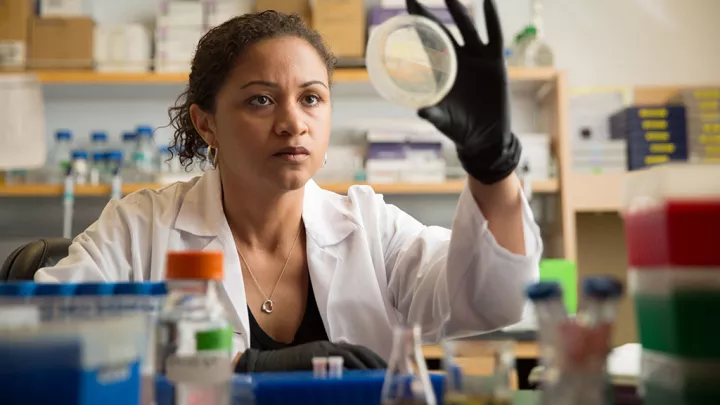
Lily C. Chao, MD, MS
Lily Chao, MD, MS examines how changes in metabolism affect muscle performance. Muscle metabolism and function are important in diabetes and many other diseases. For example, skeletal muscle not only informs locomotive function, but also has an indispensable role in systemic energy homeostasis -- or the ability to sustain the stability of internal functions. And while exercises that increase muscle mass can improve glycemic control in type 2 diabetes subjects, muscle atrophy is associated with impaired glucose metabolism. Understanding the molecular switches that control nutrient metabolism and muscle mass may have broad implications for patients with muscle atrophy stemming from a wide range of conditions including diabetes, neuromuscular diseases, spinal cord injury, chronic glucocorticoid exposure, aging, and cancer.
Type 2 diabetes
Pediatric diabetes
Disorders of pubertal development
Thyroid disorders
Short stature
Education
UCLA School of Medicine
UCLA School of Medicine
UCLA Mattel Children's Hospital
UCLA Mattel Children's Hospital
Children's Hospital Los Angeles
Accomplishments
American Board of Pediatrics, Pediatric Endocrinology
Pasadena Magazine’s Top Doctors 2011, 2012, 2013, 2014
Endocrine Society Early Investigator Award, 2014
Clinical Research Scholar, Pediatric Endocrine Society, 2013
Junior Faculty Developmental Award, UCSD/UCLA Diabetes and Endocrinology Research Center, 2011
Fellow’s Basic Research Award, Society of Pediatric Research, 2007
Research Scholar, Howard Hughes Medical Institute-National Institutes of Health, 1999-2000
Pediatric Endocrine Society - Clinical Research Scholar
Publications
Chang N, Yeh MY, Raymond JK, Geffner ME, Ryoo JH, Chao LC. Glycemic control in youth-onset type 2 diabetes correlates with weight loss. Pediatr Diabetes 21(7):1116-1125, 2020. PubMed PMID: 33103329.
Chao LC, Vidmar AP, Georgia S. Spike in diabetes ketoacidosis rates in pediatric type 2 diabetes during the Covid-19 pandemic. Diabetes Care 2021 Apr 26:dc202733.. PMID: 33905347.
Munoz CE and Chao LC. Impact of COVID-19 on youth with type 2 diabetes: lessons learned from a pediatric endocrinologist and a psychologist. Front. Endocrinol. 12:650492. PMID:34122332.
Trief PM, Uschner D, Tung M, Marcus MD, Rayas M, MacLeish S, Farrell R, Keady J, Chao LC, Weinstock RS. Diabetes distress in young adults with youth-onset type 2 diabetes: TODAY2 study. Diabetes Care 2022 Jan 11:dc211689. PMID:35015056.
Cortez-Toledo O, Schnair C, Sangngern P, Metzger D, Chao LC. Nur77 deletion impairs muscle growth during developmental myogenesis and muscle regeneration in mice. PLoS One 12(2):e0171268, 2017. PMCID: PMC5295706.
Tontonoz P, Cortez-Toledo O, Wroblewski K, Hong C, Lim L, Carranza R, Conneely O, Metzger D, Chao LC. The orphan nuclear receptor Nur77 is a determinant of myofiber size and muscle mass in mice. Mol Cell Biol 35(7):1125-38, 2015. PMCID: PMC4355536.
Tessem JS, Moss LG, Chao LC, Arlottoa M, Lu D, Jensen MV, Stephens SB, Tontonoz P, Hohmeier HE, Newgard CB. Nkx6.1 regulates islet beta-cell proliferation via Nr4a1 and Nr4a3 nuclear receptors. PNAS 111(14):5242-7, 2014. PMCID: PMC3986138.
Sallam T, Ito A, Rong X, Kim J, Van Stijn C, Chamberlain BT, Jung M, Chao LC, Jones M, Gilliland T, Wu X, Su G, Tangirala RK, Tontonoz P and Hong C. Macrophage lipopolysaccharide binding protein gene is an LXR target that promotes macrophage survival and atherosclerosis. J Lipid Res. 55(6):1120-1130, 2014. PMCID: PMC4031943.
Goddard LM, Murphy TJ, Org T, Enciso JM, Hashimoto-Partyka MK, Warren CM, Domigan CK, McDonald AI, He H, Sanchez LA, Allen NC, Orsenigo F, Chao LC, Dejana E, Tontonoz P, Mikkola HK, Iruela-Arispe ML. Progesterone receptor in the vascular endothelium triggers physiological uterine permeability preimplantation. Cell 156(3):549-62, 2014. PMCID: PMC3985399.
Beaven SW, Matveyenko A, Wroblewski K, Chao L, Wilpitz D, Hsu TW, Lentz J, Drew B, Hevener AL, Tontonoz P. Reciprocal regulation of hepatic and adipose lipogenesis by liver x receptors in obesity and insulin resistance. Cell Metab 2013, 18(1):106-17. PMCID: PMC4089509.
Chao LC, Soto E, Hong C, Ito A, Pei L, Chawla A, Conneely O, Tangirala RK, Evans RM, Tontonoz P. Bone marrow NR4A expression is not a dominant factor in the development of atherosclerosis or macrophage polarization in mice. J Lipid Res 2013, 54(3):806-15. PMCID: PMC3617954.
Chao LC, Wroblewski K, Ilkayeva OR, Stevens RD, Bain J, Meyer GA, Schenk S, Martinez L, Vergnes L, Narkar VA, Drew BG, Hong C, Boyadjian R, Hevener AL, Evans RM, Reue K, Spencer MJ, Newgard CB, Tontonoz P. Skeletal muscle Nur77 expression enhances oxidative metabolism and substrate utilization. J Lipid Res 2012, 53(12):2610-9. PMCID: PMC3494265.
Chao LC, Tontonoz P. SIRT1 regulation – it ain’t all NAD. Molecular Cell 45(1): 9-11, 2012.
Villanueva, CJ, Waki H, Godio C, Nielsen R, Chou WL, Vargas L, Wroblewski K, Schmedt C, Chao LC, Boyadjian R, Mandrup S, Hevener A, Saez E, and Tontonoz P. TLE3 is a dual function transcriptional coregulator of adipogenesis. Cell Metabolism 2011, 13(4):413-27. PMCID: PMC3089971.
Chao LC, Wroblewski K, Zhang Z, Pei L, Vergnes L, Ilkayeva OR, Ding S, Reue K, Watt MJ, Newgard CB, Pilch PF, Hevener AL, Tontonoz P. Insulin resistance and altered systemic glucose metabolism in mice lacking Nur77. Diabetes 2009, 58(12):2788-96. PMCID: PMC2780886.
Marathe C, Bradley MN, Hong C, Chao L, Wilpitz D, Salazar J, Tontonoz P. Preserved glucose tolerance in high fat diet-fed C57BL/6 mice transplanted with PPARgamma -/-, PPARdelta -/-, PPARgamma delta -/- or LXRalpha beta -/- bone marrow. J Lipid Res. 2009, 50(2):214-24. PMCID: PMC2636915.
Chao LC, Bensinger SJ, Villanueva CJ, Wroblewski K, Tontonoz P. Inhibition of adipocyte differentiation by Nur77, Nurr1 and Nor1. Mol Endocrinol 2008, 22(12):2596-608. PMCID: PMC2610364.
Chao LC, Zhang Z, Pei L, Saito T, Tontonoz P, Pilch PF. Nur77 coordinately regulates expression of genes linked to glucose metabolism in skeletal muscle. Mol Endocrinol. 2007, 21(9): 2152-63. PMCID: PMC2602962.
Hummasti S, Laffitte BA, Watson MA, Galardi C, Chao LC, Ramamurthy L, Moore JT, Tontonoz P. Liver X receptors are regulators of adipocyte gene expression but not differentiation. Identification of apoD as a direct target. J Lipid Res 2004, 45(4):616-25.
Kim JK, Fillmore JJ, Gavrilova O, Chao L, Higashimori T, Choi H, Kim HJ, Yu C, Chen Y, Qu X, Haluzik M, Reitman ML, and Shulman GI. Differential effects of rosiglitazone on skeletal muscle and liver insulin resistance in A-ZIP/F-1 fatless mice. Diabetes. 2003, 52(6): 1311-8.
Laffitte BA, Chao L, Li J, Walczak R, Hummasti S, Joseph SB, Castrillo A, Wilpitz DC, Mangelsdorf DJ, Collins JL, Saez E and Tontonoz P. Ligand activation of LXR improves glucose tolerance through coordinate regulation of glucose metabolism in liver and adipose tissue. Proc Natl Acad Sci U.S.A. 2003, 100(9): 5419-24.
Chao L, Marcus-Samuels B, Mason MM, Moitra J, Vinson C, Gavrilova O, Arioglu E, and Reitman M. Adipose tissue is required for the antidiabetic, but not for the hypolipidemic, effect of thiazolidinediones. Journal of Clinical Investigation 2000, 106(10):1221-1228.
Zinke I, Kirchner C, Chao LC, Tetzlaff MT, and Pankratz MJ. Suppression of food intake and growth by amino acids in Drosophila: the role of pumpless, a fat body expressed gene with homology to vertebrate glycine cleavage system. Development 1999, 126(23):5275-5284.
Chao LC, Jamil A, Kim SJ, Huang L, and Martinson HG. Assembly of the cleavage/polyadenylation apparatus takes at least 10 s in vivo and is faster for strong than for weak poly(A) sites. Molecular and Cellular Biology 1999, 19: 5588-5600.
Yeung G, Choi LM, Chao LC, Park NJ, Liu D, Jamil A, and Martinson HG. Poly(A)-driven and poly(A)-assisted termination: two different modes of poly(A)-dependent transcription termination. Molecular and Cellular Biology 1998, 18:276-289.
Colder BW, Wilson CL, Frysinger RC, Chao LC, Harper RM, and Engel J, Jr. Neuronal synchrony in relation to burst discharge in epileptic human temporal lobes. Journal of Neurophysiology 1996, 75:2496-2508.
Research
Lily Chao, MD, and her team are interested in understanding the physiological pathways that coordinate muscle metabolism and growth with the aim of developing new therapeutics to improve glycemic control and prevent muscle atrophy.
Research Topics
- Muscle metabolism
- Nuclear receptor signaling
- Type 2 diabetes
- Insulin signaling in muscle tissue
Research Overview
Muscle atrophy stemming from disuse, chronic inflammation, cancer, and long-term nutrient deprivation leads to functional decline and metabolic imbalance. Identification of regulatory factors that can augment muscle size may have clinical implications for treatment of sarcopenia -- the degenerative loss of skeletal muscle mass.
Lily Chao, MD, examines how changes in metabolism affect muscle performance. Muscle metabolism and function are important in diabetes and many other diseases. For example, skeletal muscle not only informs locomotive function, but also has an indispensable role in systemic energy homeostasis -- or the ability to sustain the stability of internal functions. And while exercises that increase muscle mass can improve glycemic control in type 2 diabetes subjects, muscle atrophy is associated with impaired glucose metabolism. Understanding the molecular switches that control nutrient metabolism and muscle mass may have broad implications for patients with muscle atrophy stemming from a wide range of conditions including diabetes, neuromuscular diseases, spinal cord injury, chronic glucocorticoid exposure, aging, and cancer.
Researchers at the Chao lab are studying the fundamental mechanisms that promote muscle growth. Understanding the physiological pathways that coordinate muscle metabolism and growth will serve as a portal toward the development of therapeutics to improve glycemic control and prevent muscle atrophy.
Media
The New York Times - The Pandemic Seems to Have Made Childhood Obesity Worse, but There’s Hope
Reuters - Doctors probe whether COVID-19 is causing diabetes
CHLA Research Blog
What Is Diabetic Ketoacidosis?
New Study Uncovers Spike in Life-Threatening Complication of Diabetes Type 2 During Pandemic
ResearCHLA
Treating Type 2 Diabetes in Youth
Investigating muscle loss due to genetic mutations
Cross-section of a Gastrocnemius Muscle


